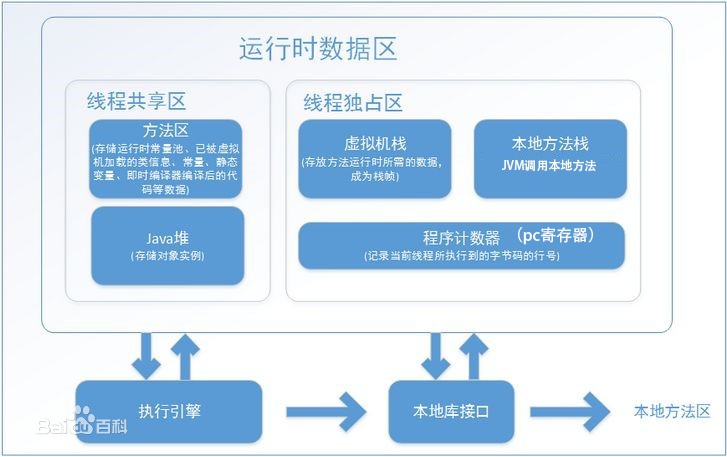String是我们接触最多的类,无论是学习中还是工作中,基本每天都会和字符串打交道,从字符串本身的各种拼接、切片、变形,再到和其他基本数据类型的转换,几乎无时无刻都在使用它,今天就让我们揭开String神秘的面纱,这一小节主要讲解String的源代码是怎么构建的,下一节是String的一些疑点难点,通常在面试中会被问到。
在学习String之前,让我们先简单的看一下JVM的内存模型,附图一张,来自百度百科:

在java的每一个通过编译生成字节码文件后,运行期JVM将字节码文件(也就是class文件)的对象通过类加载器加载到JVM运行区,如上图,通过线程独享和共享分为俩部分,其中线程共享区包括方法区和java堆,线程独享区包括虚拟机栈、本地方法栈和程序计数器
我们常说的基本类型在栈中,引用类型在堆中,其中的堆就是java堆(线程共享),栈就是虚拟机栈(线程独享),而String还涉及到方法区,因为String对象是常量,因为String其实就是char数组,而这个数组被final修饰了,详情在源代码中。
/* * * 在java程序中,所有字符串文字都是String的实例,字符串是不变的; 它们的值在创建后无法更改。 * 字符串缓冲区(StringBuffer和StringBuild)支持可变字符串。因为String对象是不可变的,所以它们可以共享。 * 例如: * String str =“abc”; * 相当于: * char data [] = {'a','b','c'}; * String str = new String(data); * String对象并不是简单的存在于堆内存中,而是在方法区的常量池中,我会在下一节详细讲解 * */ public final class String implements java.io.Serializable, Comparable<String>, CharSequence { /* * 该值用于字符存储。到这里就为什么String字符串会在常量池中我想大家一定豁然开朗了,因为final修饰的就是常量,而且不可修改,也就是说当我们定义一个 * String a = "gaoxiaolong" * 从你的程序开始跑到最后结束运行,这个"gaoxiaolong"都一直存在,当然如果被当成垃圾回收那就另当别论了。而我们可以改变的仅仅是这个String的引用a的指向: * a = "gollong",这是a的指向变了,但是"gaoxiaolong"仍然在常量池中,如果再有一个b引用,String b = "gaoxiaolong",这时这个"gaoxiaolong" * 就不用再生成了,因为已经存在了。当然如果在这期间"gaoxiaolong"已经被回收就不是这么一回事了。 */ private final char value[]; /* * 缓存字符串的哈希码,默认为0 */ private int hash; /* * 实现Serializable(序列化)接口生成的序列化UID,用于序列化和反序列化识别此对象是String对象, 我会用一章来讲解序列化和反序列化 */ private static final long serialVersionUID = -6849794470754667710L; /* * Java.io.ObjectStreamField类是可序列化字段来自Serializable类的描述。 ObjectStreamFields数组用来声明一个类的序列化字段。 * 在序列化和反序列化中详细详细讲解 */ private static final ObjectStreamField[] serialPersistentFields = new ObjectStreamField[0]; /* * 初始化新创建的String对象,使其表示空字符序列。 请注意,由于字符串是不可变的,因此不必使用此构造函数。 */ public String() { this.value = "".value; } /* * 初始化新创建的String对象,使其表示与参数相同的字符序列; * 换句话说,新创建的字符串是参数字符串的副本。 除非需要original的明确副本,否则不必使用此构造函数,因为字符串是不可变的。 * 可见官方极力推崇String a = "gaoxiaolong"的写法,这种构造器仅仅是创建一个副本。其实这个副本是在堆内存中的一个引用指向方法区中的真正的"gaoxiaolong" * 他们还是同一个"gaoxiaolong",只不过栈当中的地址值不同罢了 */ public String(String original) { this.value = original.value; this.hash = original.hash; } /* * 比较常用的一种构造方法,可以把一个字符数组转化为字符串,其实就是将这个字符数组赋值给当前引用的char[] value属性 * 分配新的String,使其表示当前包含在字符数组参数中的字符序列。 复制字符数组的内容; 后续修改字符数组不会影响新创建的字符串。 * 内部调用 Arrays工具类中的copyOf方法 */ public String(char value[]) { this.value = Arrays.copyOf(value, value.length); } /* * 这个构造器看源码我们可以看到将char数组直接赋值给当前对象的value属性,区别于上一个构造器,上一个是完全复制一份数组, * 相互之间不影响,而这个是俩个引用指向同一个数组,一个被改变另一个也会被改变。 * 但是这个构造器的访问权限是包访问权限,所以我们无法使用。不必纠结 */ String(char[] value, boolean share) { // assert share : "unshared not supported"; this.value = value; } /* * 分配一个新的String,其中包含字符数组参数的子数组中的字符。offset参数是子数组的第一个字符的索引, * count参数指定子数组的长度。 复制子阵列的内容; 后续修改字符数组不会影响新创建的字符串。 * 从源码中我们可以看出一种特殊情况:如果count = 0且offset <= value.length那么实际上就是一个空字符串 * 这里一定要记住,第三个参数是个数,也就是长度,千万不要记成结束位置,切记切记! * 这一点比较特殊,在字符串构造器中,都是offset和count参数,而在切片函数substring(int beginIndex, int endIndex)中 * 所需要的参数却是开始位置和结束位置,一定不要记混了。 */ public String(char value[], int offset, int count) { if (offset < 0) { throw new StringIndexOutOfBoundsException(offset); } if (count <= 0) { if (count < 0) { throw new StringIndexOutOfBoundsException(count); } if (offset <= value.length) { this.value = "".value; return; } } // 如果offset+count的值超过的数组的长度自然报错,如果错误信息返回的是offset+count的值,则是这个错误。 if (offset > value.length - count) { throw new StringIndexOutOfBoundsException(offset + count); } this.value = Arrays.copyOfRange(value, offset, offset + count); } /* * */ public String(int[] codePoints, int offset, int count) { if (offset < 0) { throw new StringIndexOutOfBoundsException(offset); } if (count <= 0) { if (count < 0) { throw new StringIndexOutOfBoundsException(count); } if (offset <= codePoints.length) { this.value = "".value; return; } } if (offset > codePoints.length - count) { throw new StringIndexOutOfBoundsException(offset + count); } final int end = offset + count; // Pass 1: Compute precise size of char[] int n = count; for (int i = offset; i < end; i++) { int c = codePoints[i]; if (Character.isBmpCodePoint(c)) continue; else if (Character.isValidCodePoint(c)) n++; else throw new IllegalArgumentException(Integer.toString(c)); } // Pass 2: Allocate and fill in char[] final char[] v = new char[n]; for (int i = offset, j = 0; i < end; i++, j++) { int c = codePoints[i]; if (Character.isBmpCodePoint(c)) v[j] = (char) c; else Character.toSurrogates(c, v, j++); } this.value = v; } /* * 检查边界的一个函数,在上面将字符数组转换为String对象时,我们见过了函数内的边界判断,由于关于字节的构造器过多,所以讲反复重用的代码封装成一个函数 * 到时候直接调用即可,这就是面向对象中封装的思想。 */ private static void checkBounds(byte[] bytes, int offset, int length) { if (length < 0) throw new StringIndexOutOfBoundsException(length); if (offset < 0) throw new StringIndexOutOfBoundsException(offset); if (offset > bytes.length - length) throw new StringIndexOutOfBoundsException(offset + length); } /* * */ @Deprecated public String(byte ascii[], int hibyte) { this(ascii, hibyte, 0, ascii.length); } /* * @Deprecated注解表示此方法已经过时,但仍然可以使用,只是不推荐 * ascii为要转换为字符的字节数组,hibyte为每个16位Unicode代码单元的前8位 * java使用的是Unicode编码表,每个字符都占俩个字节,但是一个字节只是一个字节,所以此方法在转换的时候 * 想指定另一个字节的数据来达到不同的需求,但是往往是不正确的转换,而使用指定charset完全可以达到此目的。 */ @Deprecated public String(byte ascii[], int hibyte, int offset, int count) { checkBounds(ascii, offset, count); char value[] = new char[count]; if (hibyte == 0) { for (int i = count; i-- > 0;) { value[i] = (char) (ascii[i + offset] & 0xff); } } else { hibyte <<= 8; for (int i = count; i-- > 0;) { value[i] = (char) (hibyte | (ascii[i + offset] & 0xff)); } } this.value = value; } /* * 下面的都是讲字节数组转换为字符串的构造器,也是方法的重载,为了适应不用的转换需求,不许参数为字节数组, * 可变参数为开始位置offset,转换长度length,指定编码方式charset,其中charset有俩种指定方式,一种是出入String类型的charsetName * 另一种是传入Charset类型的charset,如果不知道的话,offset默认为0,length默认为字节数组的长度。chatset默认为本地编码 */ public String(byte bytes[]) { this(bytes, 0, bytes.length); } /* * */ public String(byte bytes[], int offset, int length, String charsetName) throws UnsupportedEncodingException { if (charsetName == null) throw new NullPointerException("charsetName"); checkBounds(bytes, offset, length); this.value = StringCoding.decode(charsetName, bytes, offset, length); } /* * */ public String(byte bytes[], int offset, int length, Charset charset) { if (charset == null) throw new NullPointerException("charset"); checkBounds(bytes, offset, length); this.value = StringCoding.decode(charset, bytes, offset, length); } /* */ public String(byte bytes[], String charsetName) throws UnsupportedEncodingException { this(bytes, 0, bytes.length, charsetName); } /* * */ public String(byte bytes[], Charset charset) { this(bytes, 0, bytes.length, charset); } /* * 将字节数组转换为字符串,指定开始位置和长度。 */ public String(byte bytes[], int offset, int length) { checkBounds(bytes, offset, length); this.value = StringCoding.decode(bytes, offset, length); } /* * 将字符串缓冲区对象转换成String对象,实际上就是将一个堆内存中的对象写入常量池中, * 使用Arrays.copyOf复制,得到的是俩份完全独立的数组 * StringBuilder是线程不安全的,效率高 * StringBuffer是线程安全的,但代价就是效率低,效率低是相比于StringBuilder,它仍然比String快很多 */ public String(StringBuffer buffer) { synchronized (buffer) { this.value = Arrays.copyOf(buffer.getValue(), buffer.length()); } } public String(StringBuilder builder) { this.value = Arrays.copyOf(builder.getValue(), builder.length()); } }